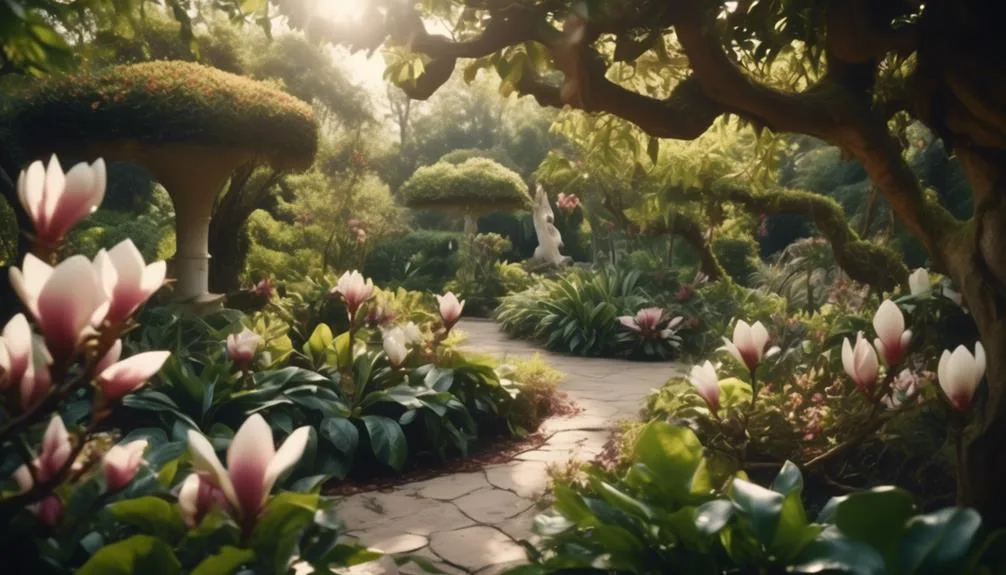Transform your backyard into a bustling wildlife haven with magnolia trees as the centerpiece. These trees offer more than just beautiful blooms; they provide a safe space for various creatures, from songbirds to pollinators.
Creating a wildlife habitat with magnolia trees is a rewarding way to support the ecosystem. But how exactly can you do this? Let's explore the steps to make your own wildlife sanctuary with magnolia trees.
Selecting the Right Magnolia Tree Species
When selecting the right magnolia tree species, consider the climate and soil conditions of your specific location to ensure optimal growth and health for your trees.
Magnolia trees thrive in well-drained, slightly acidic soils with a pH range of 5.0 to 6.5. They prefer moist, fertile soils but can tolerate a range of soil types, including sandy, loamy, or clay soils. Prioritize a location with good drainage to prevent waterlogged soil, which can lead to root rot and other diseases.
Additionally, regular pruning is essential for maintaining the shape and promoting healthy growth of magnolia trees. Prune them in late winter or early spring before new growth begins, removing dead or damaged branches and shaping the tree as needed to encourage a strong framework and abundant flowering.
Planting and Caring for Magnolia Trees
To successfully plant and care for magnolia trees, it's important to choose a well-drained location with slightly acidic soil and prioritize regular pruning for maintaining their health and promoting abundant flowering.
When planting, ensure the soil is prepared by loosening it to a depth of at least 12 inches and incorporating organic matter. Water the tree deeply and regularly, especially during dry periods, to establish a strong root system. Mulching around the base of the tree can help retain moisture and regulate soil temperature.
For pruning, focus on removing dead or damaged branches in late winter or early spring to encourage new growth and maintain an attractive shape. Additionally, monitor for signs of disease and promptly address any issues to prevent them from spreading.
Creating Shelter and Nesting Sites
Consider incorporating natural features like dense shrubs and thickets to provide shelter and nesting sites for wildlife in your habitat.
Building birdhouses can also attract birds and provide them with safe spaces to raise their young. Choose birdhouses with different entry hole sizes to accommodate various bird species.
Additionally, creating brush piles by stacking fallen branches and twigs can offer shelter for small mammals, birds, and insects. These brush piles mimic natural habitats and provide hiding spots for wildlife.
When building these nesting sites, ensure they're placed in quiet areas away from human activity to reduce disturbance.
Providing Food Sources for Wildlife
You can enhance the wildlife habitat by planting native flowers and shrubs that provide a diverse array of food sources for various species.
To attract birds and pollinators, consider incorporating the following into your wildlife habitat:
- Native Berry-Bearing Shrubs: Plant shrubs like American holly or elderberry, which produce berries that are excellent food sources for birds such as robins, cardinals, and thrushes.
- Wildflower Meadows: Create areas with native wildflowers such as coneflowers, black-eyed Susans, and bee balm to attract butterflies, bees, and hummingbirds. These pollinators are vital for the ecosystem and act as a food source for other wildlife.
- Fruit Trees: Consider adding fruit-bearing trees like serviceberry or crabapple to provide fruits that attract a variety of bird species, including orioles and waxwings.
Maintaining a Sustainable Habitat
Maintaining a sustainable wildlife habitat requires regular monitoring and thoughtful management to ensure the continued health and diversity of the ecosystem.
Wildlife preservation is crucial, and community involvement plays a significant role in achieving this. By educating and involving local communities in habitat restoration efforts, you can foster a sense of responsibility and stewardship towards the environment.
It's essential to consider the environmental impact of any maintenance activities to minimize disruption to the habitat. Regular assessments of the habitat's condition, including plant health, water quality, and wildlife population, are vital for making informed management decisions.
Conclusion
Incorporating magnolia trees into your outdoor space can create a thriving wildlife habitat. Through careful species selection, proper tree care, and providing essential resources, you can establish a sustainable environment for diverse wildlife.
As you witness the natural allure and variety of wildlife drawn to your magnolia trees, consider the impact of your efforts on local ecosystems.
Start today and cherish the beauty and vitality your habitat will nurture.

My interest in trees started when I first saw the giant sequoias in Yosemite.
I was a teenager then, and I remember thinking, “I need to learn more about this.”
That moment stuck with me.
A few years later, I went on to study forestry at Michigan Tech.
Since graduating, I’ve worked in a mix of hands-on tree care and community education.
I’ve spent over ten years helping people understand how to plant, maintain, and protect the trees in their neighborhoods.
I don’t see trees as just part of the landscape.
They are living things that make a real difference in our daily lives.
